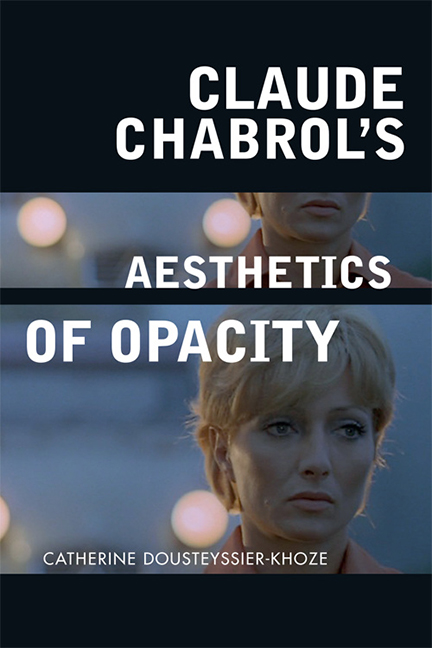Book contents
- Frontmatter
- Contents
- List of Figures
- Acknowledgements
- Dedication
- Introduction
- 1 Contexts and Influences
- 2 Chabrol and Genres
- 3 The Human Beast
- 4 Family Secrets
- 5 Chabrolean Spaces as Heterotopias of Crisis
- 6 Through the Looking Glass: Chabrol’s Mirrors and the ‘Crystal-image’
- Conclusion: Towards an Aesthetics of Visual Opacity
- Filmography
- Bibliography
- Index
3 - The Human Beast
Published online by Cambridge University Press: 10 November 2020
- Frontmatter
- Contents
- List of Figures
- Acknowledgements
- Dedication
- Introduction
- 1 Contexts and Influences
- 2 Chabrol and Genres
- 3 The Human Beast
- 4 Family Secrets
- 5 Chabrolean Spaces as Heterotopias of Crisis
- 6 Through the Looking Glass: Chabrol’s Mirrors and the ‘Crystal-image’
- Conclusion: Towards an Aesthetics of Visual Opacity
- Filmography
- Bibliography
- Index
Summary
The thriller genre so often favoured by Chabrol constitutes an ideal vehicle or alibi to conduct an exploration of evil in its various guises. As early as October 1954, Chabrol wrote a critical article entitled ‘Hitchcock devant le Mal’ (‘Hitchcock Confronts Evil’) for Cahiers du cinéma and, in his own filmography, the diverse forms and figures of evil occupy pride of place. This chapter will explore Chabrol's fascination with ‘monsters’ or ‘human beasts’ through the following (overlapping) motifs: the serial killer, the automaton and the female killer. As Punter and Byron pointed out with regard to Gothic fiction, monsters ‘as the displaced embodiment of tendencies that are repressed or, in Julia Kristeva's sense of the term, “abjected” within a specific culture not only establish the boundaries of the human, but may also challenge them’. This is what is at stake in Le Boucher, for instance, through an encounter with the violent and archaic ‘Other’. In general, the figure of the monster allows Chabrol to ‘problematize binary thinking and demand a rethinking of the boundaries and concepts of normality’. Far from providing a psychological study of evil disconnected from any societal setting or anchoring, Chabrol's exploration often integrates an ideological framework within which to think or rethink the figure of the killer. The most blatant example of this is the class war motif that lies at the heart of La Cérémonie (dubbed by Chabrol himself ‘le dernier film marxiste’ [‘the last Marxist film’]), a film in which an illiterate maid and her postal-worker friend butcher an entire bourgeois family. However, as always with Chabrol, causality is blurred to the point of opacity and the nuanced, fragmented representation of the various ‘monsters’ participate in his joint exploration of the complexities of human nature and the potential of the film image.
The Serial Killer
Chabrol is suspicious of the figure of the serial killer, which he regards as a somewhat dubious American import: ‘Le serial killer, c‘est une machine-type: il tue en série. Et c‘est devenu la figure mère de toute l‘inspiration américaine récente. Le serial killer est devenu l‘homo américanus!’ (‘The serial killer is like a machine that kills on a conveyor belt. And it has become the mother figure and inspiration for the whole American production of late. The serial killer has become the Homo Americanus!’).
- Type
- Chapter
- Information
- Claude Chabrol's Aesthetics of Opacity , pp. 72 - 103Publisher: Edinburgh University PressPrint publication year: 2017



